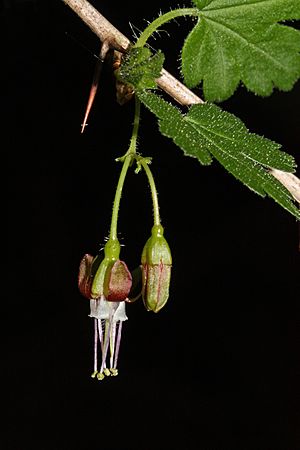Ribes divaricatum facts for kids
Quick facts for kids Ribes divaricatum |
|
|---|---|
 |
|
| Scientific classification | |
| Genus: |
Ribes
|
| Species: |
divaricatum
|
| Synonyms | |
|
List
Ribes divaricatum var. douglasii Jancz.
Ribes divaricatum var. glabriflorum Koehne in Koehne Ribes divaricatum var. rigidum M.Peck Grossularia divaricata Coville & Britton Ribes parishii A.Heller Ribes divaricatum subsp. parishii (A.Heller) A.E.Murray Ribes divaricatum var. montanum Jancz. |
|
Ribes divaricatum, also known as the spreading gooseberry, is a type of plant found in western North America. You can spot it growing in forests, woodlands, and along the coast. It stretches from British Columbia in Canada all the way down to California in the United States. This plant is part of the Ribes family, which includes many kinds of currants and gooseberries.
Contents
Different Kinds of Spreading Gooseberry
There are three main types, or varieties, of the spreading gooseberry. Each has its own common name and grows in slightly different areas:
- Ribes divaricatum var. divaricatum, or spreading gooseberry, grows in Oregon, Washington, and British Columbia.
- Ribes divaricatum var. parishii, called Parish's gooseberry, is found only in California.
- Ribes divaricatum var. pubiflorum, known as straggly gooseberry, grows in both California and Oregon.
Other common names for this plant include coast black gooseberry, wild gooseberry, and Worcesterberry.
What Does the Spreading Gooseberry Look Like?
The spreading gooseberry is a shrub that can grow quite tall, sometimes up to 3 meters (about 10 feet). Its woody branches often have one to three sharp, brown spines where the leaves attach.
The leaves are usually shaped like a hand with several lobes, and their edges have small teeth. Each leaf can be up to 6 centimeters (about 2.4 inches) long and grows on a stalk called a petiole.
Flowers and Fruit
The plant produces small clusters of hanging flowers. Each flower has green sepals that are often tinted purple and curve backward. Inside, there are smaller, lighter-colored petals. Long stamens stick out from the center of the flower.
The fruit is a sweet-tasting berry that turns black when it's ripe. It can be up to a centimeter (about 0.4 inches) wide.
This gooseberry looks a bit like Ribes lacustre and Ribes lobbii. However, Ribes lacustre has smaller, reddish flowers. Ribes lobbii has sticky leaves and reddish flowers that look like those of a fuchsia plant.
How People Use the Spreading Gooseberry
Edible Berries
The berries of the spreading gooseberry are safe to eat. They are ready to be picked and enjoyed when they turn black.
Traditional Uses by Native Americans
The fruit of this plant was an important food source for many Native American groups in the Pacific Northwest. Other parts of the plant, especially the bark, were used for traditional medicine.


